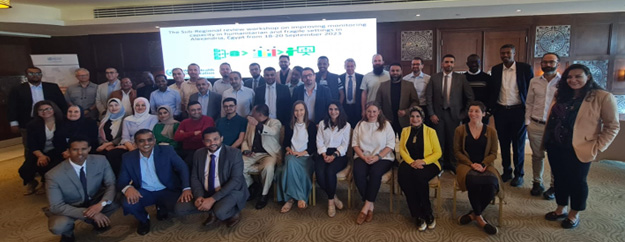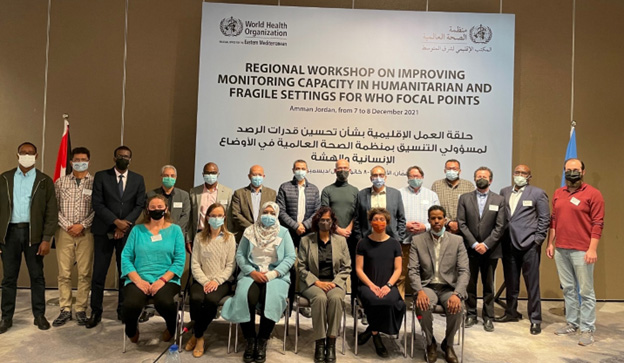 Review workshop for the first phase of the project to improve monitoring capacity in humanitarian and fragile settings, September 2023. Photo credit: WHO/Health Emergencies Programme
Review workshop for the first phase of the project to improve monitoring capacity in humanitarian and fragile settings, September 2023. Photo credit: WHO/Health Emergencies Programme
15 October 2023, Cairo, Egypt – In the complex landscape of fragile, conflict-affected and vulnerable (FCV) settings, monitoring and evaluation (M&E) play a crucial role in ensuring response efficiency and effectiveness and in improving health outcomes.
Data collection in these settings presents some unique challenges, however. These include, but are not limited to, the following:
Limited access to conflict-affected areas due to safety concerns can make it hard to reach affected populations and collect accurate data.
Displacement and mobility, with people moving frequently within and across borders, make it difficult to track and collect data on vulnerable populations over time.
Limited infrastructure and resources, including reliable internet connectivity, electricity and transportation, can hinder timely and efficient collection, storage and transmission of data.
Fragmented data collection efforts can lead to inconsistencies in data collection methodologies and indicators, which make it challenging to compare and analyse data across response efforts and countries/territories and may hinder overall data quality.
To tackle these challenges and improve the monitoring of humanitarian health action in the Eastern Mediterranean Region, WHO and Johns Hopkins University joined forces and initiated a collaborative project. The main goal was to put in place a regional response monitoring framework, to measure the effectiveness of ongoing humanitarian response at the country as well as regional level.
The Response Monitoring project focused on the standardization of indicators, an outcome-centric approach encouraging a shift away from a narrow focus on inputs and outputs to a broader assessment of the efficiency, effectiveness and timeliness of interventions and data-driven decision-making. This approach aims to promote the use of data for informed processes, planning and course correction.
Pilot successfully builds capacities
The project, which unfolded over an inception phase and an operationalization phase, was successfully piloted in 4 of the Region’s countries and territories: occupied Palestinian territory, Somalia, Syria and Yemen. During the 2 phases, significant progress was made in building response monitoring capacities in the pilot locations, enabling WHO to better track the effectiveness of humanitarian health action – and identify areas that require further attention and improvement.
“The WHO Regional Office for the Eastern Mediterranean has made good progress in the Response Monitoring initiative during its pilot phase,” remarked Dr Richard Brennan, Regional Emergency Director. “By using the framework, WHO can better monitor the effectiveness of its response in humanitarian settings, including tracking progress of key metrics over time, and comparing progress against international standards and targets. Our goal is to see this approach adopted as an organizational framework for monitoring the effectiveness of humanitarian health action.”
 Regional workshop on improving monitoring capacity in humanitarian and fragile settings, Amman, Jordan, December 2021. Photo credit: WHO/Health Emergencies Programme
Regional workshop on improving monitoring capacity in humanitarian and fragile settings, Amman, Jordan, December 2021. Photo credit: WHO/Health Emergencies Programme
A feasibility assessment carried out as part of this project revealed disparities in the ability to collect and report data on the framework both within and across countries and territories. For example, in Yemen, only 44% of the indicators were deemed feasible for use in southern Yemen, with only 28% of the indicators deemed feasible for collection and reporting in the north of the country. This has highlighted the need for greater investment and efforts to capacitate FCV settings to report against the framework. This work is planned for the next phase of the project, along with its potential expansion to other FCV settings in the Region, as well as beyond, including South Sudan and Ukraine.
To complement response monitoring at the country level, WHO also rolled out the Health Resource Availability Mapping System (HeRAMS) in 6 of the Region’s countries and territories. This tool allows for the collection and analysis of data on functionality, capacities and staffing of health facilities. HeRAMS serves as a valuable source of data for over 60% of the indicators required by the response monitoring framework. The data collected through HeRAMS are increasingly used to identify gaps in service availability and to target operational priorities.
The success of this collaborative initiative between WHO and Johns Hopkins University shows the potential and need to enhance response monitoring capacity in humanitarian and FCV settings. Sustainability and expansion plans have been put in place and efforts are under way to sustain the gains made in the pilot locations and expand the initiative to all FCV settings within the Eastern Mediterranean Region, as well as to other WHO regions.




